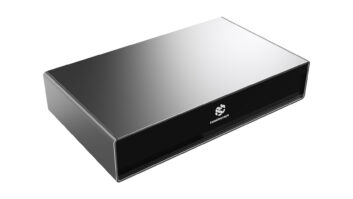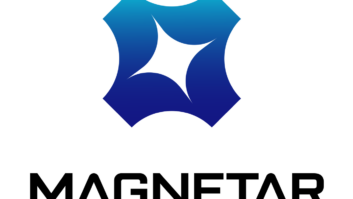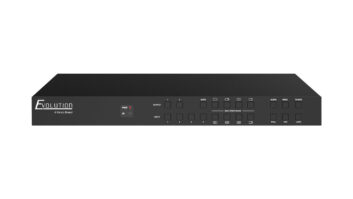DVD and memory cards, with a strong plug for D-VHS, shared the spotlight last week at the Japan Electronics Show ’99 (JES) in Chiba, just outside of Tokyo.
JVC, Panasonic, Pioneer, Sony and Toshiba were among the exhibitors staking claims to the “digital world of the 21st century,” a phrase used in one form or another by many manufacturers at JES. But whether it is the 20th or 21st century, it still is the consumer electronics business, and format battles ensued, whether it involved a relatively new category such as memory cards, or DVD.
In addition, there were new developments in MiniDisc, home networking, and large-screen LCD and plasma TVs (see the next issue of TWICE and www.TWICE.com for further details). DVD, memory cards and D-VHS also caught the attention of many showgoers.
Based on actual and prototype products shown at JES, DVD — with strong competition from hard disk drives and possibly D-VHS — looks like the home audio/video/PC format of the future. Memory cards are being designed for portable devices such as digital cameras and portable audio players into which content from home can be downloaded and taken anywhere.
Here is a breakdown of JES highlights:
DVD: New DVD-Video recorders and DVD-Audio players were in evidence. Panasonic showed a DVD video recorder that uses 4.7GB rewritable DVD-RAM discs developed under the DVD Forum and approved by the organization’s steering committee.
Although no model number or pricing was available, Panasonic estimated that its DVD recorder would ship in the spring in both Japan and the U.S.
Panasonic’s deck stores 120 minutes of MPEG-2 video on a single side of a DVD-RAM disc. Unit specs also call for “Rewritable/Re-recordable Disc Part 3” video recording, which enables real-time video recording and playback. Other possible uses for the system include recording and reading various kinds of data, such as video, still image, sound and PC data files from the same disc. Decks can play all types of DVD and CD software.
However, discs recorded by this unit, and future DVD-RAM decks from other companies, will not be backward compatible with existing DVD players, said Sakon Nagasaki, director of Matsushita’s DVD Business Development Office. He challenged the claim made by Philips that its DVD+RW recording format is designed for backward compatibility with today’s DVD video players.
Pioneer, meanwhile, has said its DVD-R/W format for video recording would be compatible with future DVD players but not players currently on the market without upgrading.
“The DVD-RAM spec selected was the best format usage for audio/video and PC applications,” Nagasaki said. “But certain manufacturers are not telling the truth when they talk about compatibility. DVD players must be modified to play” DVD discs recorded at home, he claimed.
Panasonic said that DVD camcorders are possible, but showed a prototype digital camcorder using its Secure Disk (SD) memory card. During the press briefing Kirk Nakamura, president of Matsushita’s AVC company said digital camcorders will be stressed early on, diplomatically adding, “smaller is better… but that doesn’t mean we won’t develop” a DVD-RAM camcorder.
Pioneer launched two DVD-Audio/Video players. The DV-AX10 is set to ship during late December at 500,000 yen in Japan, or less than $5,000. The DV-S10A will ship at the same time at a suggested retail of 200,000 yen, or less than $2,000.
Pioneer also displayed car navigation DVD and portable DVD players.
Hitachi, meanwhile, showed 4.7GB and 2.6GB DVD-RAM decks for the Japanese market.
Memory Cards: Shown at one end of the convention center at Matsushita’s Panasonic booth was a new memory card technology, Secure Disk (SD), developed in conjunction with SanDisk and Toshiba. At the other end was Sony, pushing its Memory Stick format.
Panasonic showed 22 prototype products that could use SD, including DVD players, cellular phones, Internet music players, still cameras and video printers. SD sizes shown were 32, 64, 128, 256 and 512MB, and 1GB. An SD-based SDMI-compliant music player is scheduled to be introduced by Panasonic next spring, in 32MB and 64MB sizes.
Not to be outdone, Toshiba showed SD-based prototypes of PDAs, still-video printers and cameras, an MPEG cellular video phone, and a Libretto-brand notebook PC.
Sony showed a Walkman portable audio player, Cyber Shot digital cameras, VAIO PCs, and a digital Handycam camcorder — all of which use Memory Stick media.
One of the digital Handycam camcorders shown, the DCR-PC1000, has a 1,070K-pixel capability and will retail in Japan for 235,000 yen, or more than $2,200.
Other prototype products using Memory Stick included a 15″ LCD personal TV, digital camera, digital image scanners and other products. Memory Stick sizes were: 4, 8, 16, 32, 64, 128 and 256MB.
D-VHS: Not wanting to have its VHS format get lost in all the DVD hoopla, JVC demonstrated the D-VHS “LS3 mode,” which produces 24-hour recording. The company also compared the picture quality between D-VHS STD mode and S-VHS tapes and demonstrated dubbing tapes in DVC format to D-VHS.
JVC highlighted D-VHS as a core to any home theater of the future, including DVD and DVD Audio. As part of what it called the “Home AV Network” zone, D-VHS was positioned by JVC as a core technology for the emerging market. The company highlighted its compatibility with VHS and pointed out such key benefits as a 44GB storage capacity per cassette and MPEG-compatible bitstream recording system.













